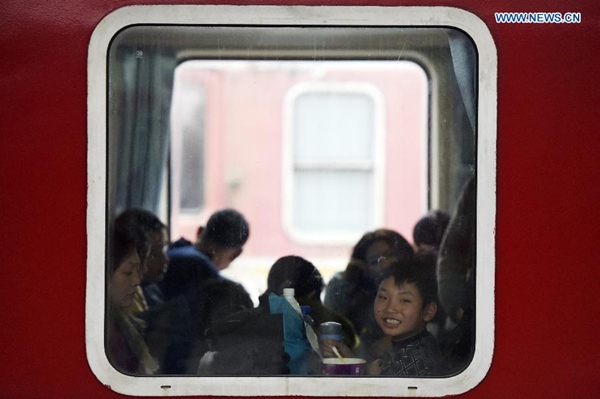World's biggest travel rush under way
(Xinhua) Updated: 2015-02-04 19:45
 |
|
A boy on a train home looks out of the window at the railway station of Hangzhou, capital of East China's Zhejiang province, Feb 3, 2015. [Photo/Xinhua] More Photos |
BEIJING -- The world's most populous country kicked off its largest seasonal travel rush on Wednesday with an expected 2.8 billion trips during the 40-day Lunar New Year holiday season.
Taking place annually fourteen days ahead of the Spring Festival holiday, the travel spree, known as "Chunyun" in Chinese, is considered the world's largest human migration, with hundreds of millions of Chinese people traveling home to reunite with family.
This year's number of trips would be 3.4 percent higher than that of last year, according to official estimation.
RAILWAY TRAVEL
China's rail system is expected to handle 300 million trips during the travel rush, up 10 percent from last year. It represents the highest growth of all forms of passenger transportation, according to figures from the National Development and Reform Commission.
This year's growth is expected to be better managed, with the official ticket purchasing website, 12306.cn, opening "Chunyun" ticket sales 60 days ahead of the festival, compared with 20 day in advance in previous years.
This is expected to encourage passengers to plan early and avoid rush hour trips.
Online ticket sales have helped reduce crowds at ticket booths. Beijing West Railway Station, the city's busiest, on Wednesday reported less queues of people to purchase tickets.
In the past, ticket booths in large cities were overwhelmed during the Spring Festival period, with people waiting hours, in some cases days, to make a purchase.
Song Jianguo, the station's spokesman, said the peak period is expected between Feb. 13 and 18, with a record of 230,000 passengers to use the station daily.
He said during the travel rush, they will handle 204 train arrivals and departures a day, meaning a bullet train arrives every 4 minutes and a regular train every five minutes.
However, not all cities have experienced explosive growth during the country's biggest holiday season.
In recent years, the daily "Chunyun" passenger volume in Shanghai has been gradually shrinking, said Zhu Wenzhong, head of Shanghai Railway Station.
This year is no exception, with the station expecting an even smaller crowd than that recorded during the week-long National Day holiday in October, he said.
The estimated 47.5 million passengers expected to travel by airplane, up 8 percent year on year, will see cheaper tickets than normal, as airlines prepare to remove the fuel surcharge on Thursday.
LESS TRIPS FROM COASTS TO INLAND
Over the past decade, hundreds of thousands of migrant workers would take to the nation's expressways on motorcycles, braving the wind and rain for days in order to return home to see their families.
However, as more manufacturing firms move from China's coastal regions to inland provinces, less migrant workers hit the road during "Chunyun" for the arduous and money-saving motorcycle journey.
Big employers such as Taiwan-based Foxconn Technology Group, the supplier for some of the world's biggest tech brands, including Apple, have set up plants in inland places like Henan and Sichuan provinces, absorbing local laborers that used to travel to coastal regions for better-paid jobs.
A spokesman with the public security bureau in Wuzhou City, southwest China's Guangxi Zhuang Autonomous Region, said this year, 300,000 people are expected to ride motorcycles from coastal regions back to their homes in Wuzhou, down from 400,000 during the travel rush in 2013.
In addition to industrial transfer, newly opened high-speed railways linking China's underdeveloped regions with bustling transportation hubs in better developed areas have also helped facilitate travel.
Three new high speed railway lines officially opened in December, reaching far west to the Xinjiang Uygur Autonomous Region, and southwest to Guangxi and Guizhou Province, where a lack of transportation facilities has been a major hurdle for economic growth.
- Spring Festival travel rush kicks off
- Beijing Railway Station prepares for spring festival travel rush
- Qingdao Railway Station prepares for Spring Festival travel rush
- Holiday travel rush tests China's railways
- Snipers added to Beijing train stations for summer travel rush
- West Lake embraces travel rush period on Labor Day
- Govt encourages people to work 4.5 days a week
- Action to be taken as HIV cases among students rise
- Debate grows over reproductive rights
- Country's first bishop ordained in 3 years
- China builds Tibetan Buddhism academy in Chengdu
- Authorities require reporting of HIV infections at schools
- Typhoon Soudelor kills 14 in East China
- Police crack down on overseas gambling site
- Debate over death penalty for child traffickers goes on
- Beijing to tighten mail security for war anniversary







